It has been confirmed by the U.S. Army Corps of Engineers that they want to issue a crucial permit authorizing construction of the proposed Rosemont Mine in the Santa Rita Mountains southeast of Tucson. Along with this the U.S. Environmental Protection Agency’s regional office, which had been regularly blasting the $2 billion project since 2012 states that it would not send the mine issue to its Washington, D.C., office for additional review.
The change by the EPA is a huge boost for the mine project as an EPA move to elevate it could have delayed the already-delayed project for months more and maybe led to an EPA veto.
Word of the Corps’ intent to ratify the project and the EPA’s withdrawal from the case first surfaced in an email sent Thursday, Feb. 28. The mail has been surfaced by a top EPA official to an attorney for the Tohono O’Odham Nation and two other Arizona tribes. The mail has been received from Michael Stoker, administrator for the EPA’s San Francisco regional office that governs Arizona issues, and offered no reason for the agency’s decision.
It should be noted that a proposed Clean Water Act permit for the mine is at stake. It would allow dredging and filling about 40 acres of washes. This is the final permit required for the mine to start construction and one that’s likely to be argued for some time in court due to lawsuits if it’s issued.
The mine would be built by Toronto-based Hudbay Minerals Inc., and it would employ more than 400 people for around 20 years in an area about 30 miles southeast of Tucson.
The tribal attorney, Stu Gillespie of the Earthjustice environmental law firm, wrote Stoker back Friday, requesting “meaningful, government to government consultation with you regarding this monumental decision.”
As per federal law and EPA policy, such a consultation is required said Gillespie in his email. His firm also represents the Pascua-Yaqui and Hopi tribes. All of them have opposed the mine out of concern it would damage areas they consider ancestral homelands.
The EPA also told Friday night that it isn’t elevating the Rosemont issue to Washington, D.C. The agency’s action met a deadline set by the Corps to decide on that question. Usually, permit requests are reviewed by both EPA and the Corps, with either agency able to elevate cases to Washington when disagreements occur, the EPA said.
On February 14, the EPA received the Corps’ draft permit for the proposed mine, the EPA said in a statement. The corps on Monday said it had provided the EPA a notice of intent to issue the Rosemont permit, although the permit isn’t final until its officials sign it, likely to come late this week or early next week.
However, the corps has refused to issue any comment on the permit issues until a final decision is reached, said Mike Petersen, a spokesman for the agency’s South Pacific Division, which is handling the case.
Attorney Gillespie to the EPA’s Stoker said the agency hasn’t consulted with tribal leaders about its decision not to elevate the Rosemont issue and called Stoker’s email “too little, too late.”
“It did not provide tribal leaders with an opportunity to respond, let alone engage in consultation. Indeed, your email suggests that you had made your decision, before even reaching out to the tribes,” Gillespie said.
He also has requested Stoker seeking an extension of EPA’s deadline for reviewing the Rosemont permit “so that you can meaningfully consult with tribal leaders regarding the significant impacts of the proposed Rosemont mine on aquatic, cultural, religious, spiritual, and historic properties.”
On Saturday Stoker wrote, “I appreciate you reaching out and expressing your thoughts on behalf of the Tohono O’odham Nation.” He added that he had asked his regional counsel, Sylvia Quast, to respond to Gillespie’s email. As of Monday, Gillespie said he was yet to receive an explanation of the EPA’s decision.
EPA officials have initially selected Rosemont in January 2012 as a project with serious enough environmental impacts to make it a potential candidate for elevating to its main office for further review. From that time EPA regional officials have written seven other lengthy letters and memos warning the mine will cause serious impacts. The letters talk of drawing down the aquifer, drying up wells, polluting surface waters and reducing water flows from washes at the mine site into neighboring Davidson Canyon and Cienega Creek. The criticisms have arisen during both Trump and Obama administration.
It should be reported that EPA has been regularly signaling out these creeks for special attention, calling them “Aquatic Resources of National Importance.” For any project to be considered for national attention the agency must determine that it “may result in substantial and unacceptable impacts” to such water bodies, the EPA’s website said.
In return, officials of Hudbay Minerals, Rosemont’s current proponent, and its predecessor Augusta Resource Corp. has written numerous letters criticizing the EPA’s reasoning, the accuracy of its comments and its science. As per Hudbay, the EPA has dramatically overstated the mine’s potential impacts and relied on speculative forecasts to make a case that the mine’s impacts would be severe. He also added that the mine is unlikely to have significant effects on aquatic resources and those that do occur “will be distant in time” and “quite small if they occur at all.”
